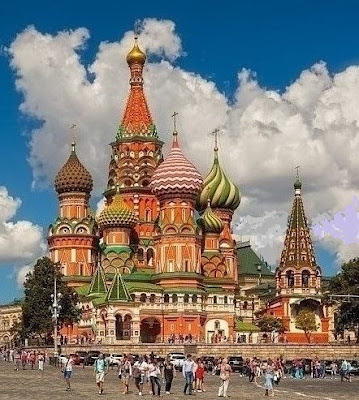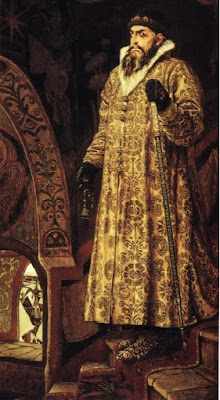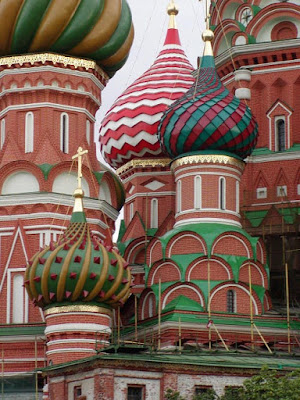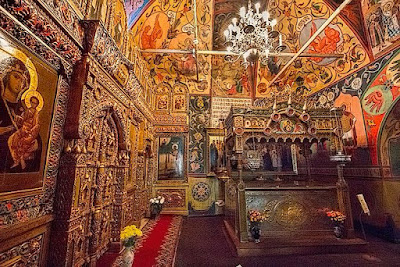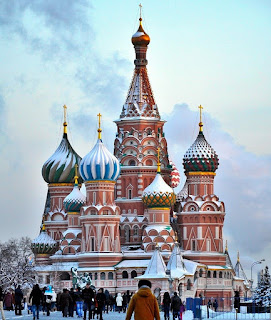Ivan IV the Terrible (1530–84) was Grand Prince of Moscow and Tsar of Russia from 1547. His reign saw the completion of a centrally administered Russian state and the creation of an empire that included non-Slav states.
Naturally the Tsar’s aim of military dominance over a central Russian state led to many conflicts. In the 1550s his armies defeated the independent Tatar/Mongol khanates of Kazan and Astrakahn. This extended Muscovy control to the Urals in the east and the Caspian Sea in the south, creating a buffer zone against the Mongols. Ivan’s second goal was to gain access to the Baltic Sea. However this time he was not as successful in annexing Lithuania and gaining sea access.
Ivan returned to a hero’s welcome in Moscow and to news that his wife gave him a son, though the infant soon died. In Kazan the Muslim population was expelled and Russian colonists were moved in, mosques were replaced by Russian Orthodox churches and the Tartars of the surrounding country were pressed to convert to Christianity.
St Basil's Cathedral, Red Square
Tsar Ivan the Terrible
painted by Viktor Vasnetsov (1848-1926)
In St Basil, western academic architectural concepts based on rational harmony were ignored; the structure, with no clear design and many different exterior decorations, was a strangely medieval Russian form and decoration. No-one would ever confuse St Basil’s in Moscow with, for example, the romanesque Durham Cathedral, the gothic Notre-Dame de Paris or the baroque St Paul’s in Rome.
The flame-shaped roofs of St. Basil's Cathedral, which were said to be based on the colours describing heaven in the Book of Revelation, were probably not always as colourful as they are today. Before the 17th century, it's likely they were painted white, red and gold. 8 of the 9 domes built on the Cathedral represented the number of attacks on Kazan, and were originally gold. Small renovations continued until the mid C19th when the domes were given their current bright colours and patterns. The 9th dome, the small one to one side, marks the sanctuary of Basil the Blessed.
This cathedral was a great example of the union of Byzantine and Asiatic cultural streams that characterised Muscovite culture. The inter-connected chapels, with their doors, artworks and niches, made the interior of St Basil's seem unworldly. The iconostasis was a wall of icons and religious paintings, separating the nave from the sanctuary.
There were nine tiny chapels clustered around a central nave, each topped with a brightly coloured, onion-shaped dome. The nine small, separate chapels were aligned to points on the compass, four of which were raised to designate their position between heaven and earth. The first 8 chapels were dedicated to important events eg the Protecting Veil of Mary; or the Entry into Jerusalem. The 9th chapel was added in honour of St Basil. The inside of the chapels, though quite small, were still richly decorated.
The interior walls are meticulously painted with intricate floral designs and Christian motifs. Explore the very narrow labyrinth of corridors and tiny oratories.
Survival was a fickle issue. The 1812 Fire of Moscow broke out when Russian troops and residents abandoned the city, just as the Napoleonic troops entered the city. The fire all but destroyed the city, yet St Basil Cathedral was spared! Even Napoleon’s specific order to his troops to blow up the cathedral failed; the fuses lit by the Frenchmen were snuffed by sudden rain. Perhaps Napoleon, realising he could not count St Basil's Cathedral among his war spoils, had a hissy fit and demanded it destroyed. Or perhaps the Moscow cathedral offended Napoleon’s architectural taste.
The cathedral’s exterior colour was originally white, to match the Kremlin’s white stone. Starting in the C17th, the façade began to be painted in the bright colours that are still seen today. The colourful exterior of the cathedral is constantly maintained by fresh coats of paint.
Moscow’s large open Red Square market area had been the geographic centre of Russian life since the C15th. Red Square covered an area of 800,000 sq feet, housing the historic government Kremlin building at its western end. Some beautiful cathedrals were located in Cathedral Square, while other historic sites in Red Square included the State Historical Museum and Lenin’s Tomb.
After Lenin's death in Jan 1924, Stalin grabbed power. St Basil’s became a secular tourist attraction, used as a museum. But the church became an obstacle for Stalin’s plans to open up Red Square for political power displays. In 1933, the cathedral was deleted from the heritage register. Architect Pitor Baranovsky was summoned to do the last survey of the church scheduled for demolition, and was then gaoled for refusing to destroy the Cathedral as instructed. By 1937 even brutal Stalin admitted that the church had to be saved.
Red Square in the snow
Only since the Soviet Union ended in 1990 have occasional church services been held in this cathedral. The Kremlin, cathedral and Red Square were named a World Heritage Site by UNESCO in 1990. However St Basil’s Cathedral is neither the city’s main cathedral, nor the headquarters of the Orthodox Patriarch of Moscow.
Naturally the Tsar’s aim of military dominance over a central Russian state led to many conflicts. In the 1550s his armies defeated the independent Tatar/Mongol khanates of Kazan and Astrakahn. This extended Muscovy control to the Urals in the east and the Caspian Sea in the south, creating a buffer zone against the Mongols. Ivan’s second goal was to gain access to the Baltic Sea. However this time he was not as successful in annexing Lithuania and gaining sea access.
Ivan returned to a hero’s welcome in Moscow and to news that his wife gave him a son, though the infant soon died. In Kazan the Muslim population was expelled and Russian colonists were moved in, mosques were replaced by Russian Orthodox churches and the Tartars of the surrounding country were pressed to convert to Christianity.
St Basil's Cathedral, Red Square
Tsar Ivan the Terrible
painted by Viktor Vasnetsov (1848-1926)
St Basil was a votive offering, commemorating the Russian capture of the Tatar capital, Kazar. The church was at first dedicated to the intercession of the Virgin by the Moat, but it came to be known as the Cathedral of Vasily the Beatified/Basil the Blessed. Basil, a contemporary of Ivan the Terrible, was the peasant lad who became holy for Christ’s sake and who was buried in the church vaults.
In St Basil, western academic architectural concepts based on rational harmony were ignored; the structure, with no clear design and many different exterior decorations, was a strangely medieval Russian form and decoration. No-one would ever confuse St Basil’s in Moscow with, for example, the romanesque Durham Cathedral, the gothic Notre-Dame de Paris or the baroque St Paul’s in Rome.
The flame-shaped roofs of St. Basil's Cathedral, which were said to be based on the colours describing heaven in the Book of Revelation, were probably not always as colourful as they are today. Before the 17th century, it's likely they were painted white, red and gold. 8 of the 9 domes built on the Cathedral represented the number of attacks on Kazan, and were originally gold. Small renovations continued until the mid C19th when the domes were given their current bright colours and patterns. The 9th dome, the small one to one side, marks the sanctuary of Basil the Blessed.
This cathedral was a great example of the union of Byzantine and Asiatic cultural streams that characterised Muscovite culture. The inter-connected chapels, with their doors, artworks and niches, made the interior of St Basil's seem unworldly. The iconostasis was a wall of icons and religious paintings, separating the nave from the sanctuary.
There were nine tiny chapels clustered around a central nave, each topped with a brightly coloured, onion-shaped dome. The nine small, separate chapels were aligned to points on the compass, four of which were raised to designate their position between heaven and earth. The first 8 chapels were dedicated to important events eg the Protecting Veil of Mary; or the Entry into Jerusalem. The 9th chapel was added in honour of St Basil. The inside of the chapels, though quite small, were still richly decorated.
Ivan saw the cathedral’s completion in 1561, yet his rage continued. Now he beat his pregnant daughter-in-law, causing a miscarriage, and killed his son in a fit of rage. And he intentionally blinded the cathedral’s Italian architect, saying he wanted to ensure that its beautiful design could never be replicated elsewhere. I am not surprised that later, when he died, Ivan was interred elsewhere (at the nearby Archangel Cathedral). His son became Tsar Feodor I in 1584.
8 of the 9 onion domes featured on St. Basil's Cathedral
represented the 8 attacks on the Khanate of Kazan
The interior walls are meticulously painted with intricate floral designs and Christian motifs. Explore the very narrow labyrinth of corridors and tiny oratories.
Survival was a fickle issue. The 1812 Fire of Moscow broke out when Russian troops and residents abandoned the city, just as the Napoleonic troops entered the city. The fire all but destroyed the city, yet St Basil Cathedral was spared! Even Napoleon’s specific order to his troops to blow up the cathedral failed; the fuses lit by the Frenchmen were snuffed by sudden rain. Perhaps Napoleon, realising he could not count St Basil's Cathedral among his war spoils, had a hissy fit and demanded it destroyed. Or perhaps the Moscow cathedral offended Napoleon’s architectural taste.
The cathedral’s exterior colour was originally white, to match the Kremlin’s white stone. Starting in the C17th, the façade began to be painted in the bright colours that are still seen today. The colourful exterior of the cathedral is constantly maintained by fresh coats of paint.
Moscow’s large open Red Square market area had been the geographic centre of Russian life since the C15th. Red Square covered an area of 800,000 sq feet, housing the historic government Kremlin building at its western end. Some beautiful cathedrals were located in Cathedral Square, while other historic sites in Red Square included the State Historical Museum and Lenin’s Tomb.
After Lenin's death in Jan 1924, Stalin grabbed power. St Basil’s became a secular tourist attraction, used as a museum. But the church became an obstacle for Stalin’s plans to open up Red Square for political power displays. In 1933, the cathedral was deleted from the heritage register. Architect Pitor Baranovsky was summoned to do the last survey of the church scheduled for demolition, and was then gaoled for refusing to destroy the Cathedral as instructed. By 1937 even brutal Stalin admitted that the church had to be saved.
Red Square in the snow
Only since the Soviet Union ended in 1990 have occasional church services been held in this cathedral. The Kremlin, cathedral and Red Square were named a World Heritage Site by UNESCO in 1990. However St Basil’s Cathedral is neither the city’s main cathedral, nor the headquarters of the Orthodox Patriarch of Moscow.
